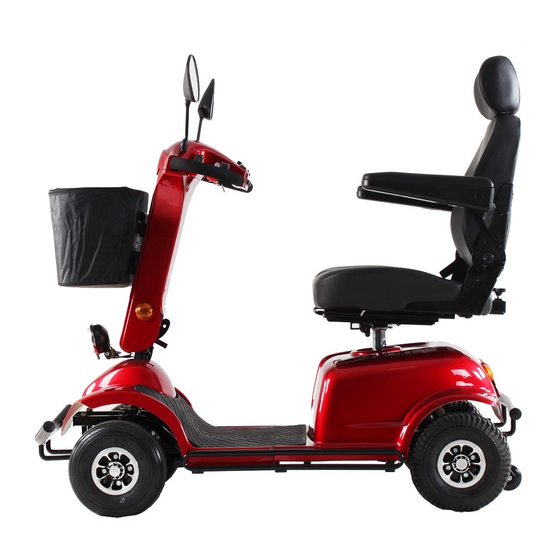
Advertisement
Quick Links
USER'S MANUAL MOBILITY SCOOTER - ES400 / ES500
Read the User Manual carefully before operating the ES400/ES500.
If you do not fully understand any part of this manual, please contact your dealer or
any of our Service Centres.
Read this manual step by step, as injury or damage may occur from misuse!
Electromagnetic Interference ("EMI") can cause powered vehicles to behave
erratically, which could be dangerous to the user.
For your safety and protection, it is IMPERATIVE that you take time to read
Chapter V ("EMI WARNING") before operating the ES400/ES500.
WARNING
WARNING
Advertisement

Summary of Contents for OrthoDuad ES400
- Page 1 USER’S MANUAL MOBILITY SCOOTER - ES400 / ES500 WARNING Read the User Manual carefully before operating the ES400/ES500. If you do not fully understand any part of this manual, please contact your dealer or any of our Service Centres. Read this manual step by step, as injury or damage may occur from misuse! WARNING Electromagnetic Interference (“EMI”) can cause powered vehicles to behave...
-
Page 2: Table Of Contents
TABLE OF CONTENTS Introduction Specifications III. Features Operating your scooter Safety Instructions Battery Charging VII. Maintenance Schedule VIII. Warranty... -
Page 3: Introduction
This manual contains important information concerning the safe operation and proper maintenance of your scooters. Your ES400 has many unique features not found on other scooters. With proper care and maintenance, you should enjoy many years of dependable service from your unit. -
Page 4: Specifications
Range with Full Charge Up to 40km Turning Radius 1.2m DIMENSIONS Length 51’’ Width 25’’ WEIGHT Total (with battery) 98kg – 215lbs BATTERY SPECIFICATIONS 12V/38 Ah Lead-acid battery BATTERY CHARGER Input AC /110V/60Hz Output DC24V/ 5amp MOTOR POWER ES400: 400W / ES500: 450W... -
Page 5: Features
III. FEATURES Swing away armrests 360 degrees swivel seat Adjustable Forward/Reverse Seat Adjustable tiller Dynamic regenerative braking Rear wheel direct drive with differential Fully solid state controller External Battery Charger 24-volt permanent magnet heavy duty DC motor ... -
Page 6: Operating Your Scooter
OPERATING YOUR SCOOTER The photo below shows the operating controls of your mobility scooter. Battery status indicator Charger socket Key Switch High/Low speed mode switch Throttle control lever Throttle control lever Headlight switch Turning lights Speed limit dial switch Horn Horn... - Page 7 1, BEFORE OPERATION 1). Insert the power key into the switch lock and turn clockwise to the ON position. 2). Check the battery charge indicator to make sure the batteries are fully charged. 3). Make sure that clutch lever is at close position. 2, TURN POWER ON Insert the key into the key switch on the upper tiller and rotate clockwise to the “ON”...
- Page 8 Stand beside the ES400/ES500 to engage or disengage freewheel mode. Never do this while sitting on the ES400/ES500. After you have finished pushing your ES400/ES500, always return it to the drive mode to lock the brakes (pull the manual freewheel lever backward).
-
Page 9: Safety Instructions
V. SAFETY INSTRUCTIONS Your scooter can move on grass , gravel, dirt, and sand surfaces, as well as hard paved or carpeted surfaces. However, extra caution should be taken when operating your unit on uneven surfaces other than flat surfaces. ... - Page 10 CAUTION: IT IS VERY IMPORTANT THAT YOU READ THIS INFORMATION REGARDING THE POSSIBLE EFFECTS OF ELECTROMAGNETIC INTERFERENCE ON YOUR POWERED SCOOTER. Electromagnetic Interference (EMI) From Radio Wave Sources Powered wheelchairs and motorized scooters (in this text, both will be referred to as powered wheelchairs) may be susceptible to electromagnetic interference (EMI), which is interfering electromagnetic energy (EM) emitted from sources such as radio stations, TV stations, amateur radio (HAM) transmitters, two-way...
- Page 11 The sources of radiated EMI can be broadly classified into three types: 1) Hand-held portable transceivers (transmitters-receivers) with the antenna mounted directly on the transmitting unit. Examples include: citizens band (CB) radios, “walkie talkie,” security, fire, and police transceivers, cellular telephones, and other personal communication devices.
- Page 12 2) Be aware of nearby transmitters, such as radio or TV stations, and try to avoid coming close to them; 3) If unintended movement or brake release occurs, turn the powered scooter OFF as soon as it is safe. 4) Be aware that adding accessories or components, or modifying the powered scooter, may make it more susceptible to EMI (Note: There is no easy way to evaluate their effect on the overall immunity of the powered scooter.
- Page 13 In summary, - DO NOT try to climb sharp curbs. - DO NOT drive off or over obstacles exceeding 5 cm in height. - DO NOT make abrupt changes in direction at high speed or while traveling on an incline. - DO NOT climb inclines greater than 12 degrees or a rise of - DO NOT move backward on uneven surfaces or inclines.
-
Page 14: Battery Charging
4. Under ideal storage conditions, batteries that were charged to full capacity and were not used should be recharged every month. 5. If you expect not to use your ES400/ES500 for an extended period of time, we recommend charging it for two days and then disconnecting the batteries. -
Page 15: Maintenance Schedule
VII. MAINTENENCE SCHEDULE In order to obtain the best performance and lasting service life, please maintain your unit according to the following schedule and instructions: DAILY Test brake effectiveness before you drive. Recharge battery fully every night. WEEKLY 1. Check tire pressure. Pressure should be 40 - 50 psi. 2. -
Page 16: Warranty
VIII. WARRANTY The Orthoquad ES400/ES500 are covered by a full warranty on all components of the product for 1 year. The Orthoquad ES500 only have a 2 year warranty on the powertrain ES400/ES500 Batteries guaranteed for 3 months.

Need help?
Do you have a question about the ES400 and is the answer not in the manual?
Questions and answers